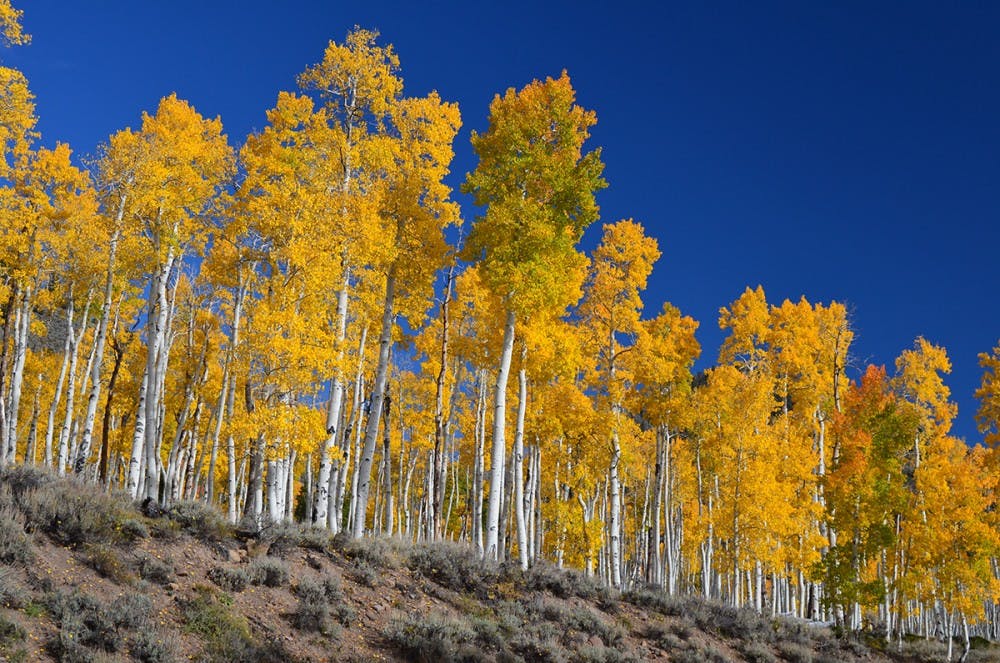The most massive organism on earth is not, as one might expect, a blue whale or a giant sequoia but a forest of quaking aspens. Pando, consisting of around 47,000 individual trunks spread across 106 acres, is a clonal colony whose source is a single male tree. The trunks are genetically identical and share a massive underground root system.
Quaking aspens typically form such groves of clones across the cooler areas of North America. Clusters of the slim, pale-barked trees can be found from Canada down into the United States. Pando, found in Utah, is simply the largest.
It is also shrinking. The death of mature trunks is routine, and while Pando has been predicted to be thousands of years old, individual trunks only live to be around 100-150 years old. New stems have historically grown from the root system, but now the older, dying trees are no longer being replaced at the same rate.
A paper published in PLOS ONE earlier in October by researchers from Utah State University implicated herbivores and human activities as major factors contributing to the organism’s decline.
The study examined three areas of Pando. The first area was completely untouched. Parts of the second area had been treated by the U.S. Forest Service in recent years, including burning and partial cutting, and the entire region was fenced. The third area was also fenced but was untreated. None of these interventions had been conducted by the researchers themselves.
The researchers collected data from 65 locations within these three areas, taking note of factors including elevation of the location, condition of the aspens in the area, number of young stems and presence of animal feces.
In addition, the study analyzed six aerial images taken between 1939 and 2011. These provided a striking visual of Pando’s change, showing that the area covered by aspens has been shrinking over the course of the seven decades. The increase of human activity in the area can also be observed from the photographs, with the appearance of campgrounds, roads and other structures.
The culprit most directly responsible for Pando’s decline was suggested to be herbivores. Where the grove is not effectively fenced, mule deer and domestic cattle can forage, eating young aspens. The researchers recorded that the herbivores have been grazing at unsustainable rates, stunting Pando’s regeneration.
Human activity, however, has had a significant impact on the herbivores and by extension, the grove. The depletion or removal of natural predators, along with bans on hunting near the recreational areas within Pando, have contributed to steep rises in herbivore numbers. Mule deer fleeing human activity elsewhere have also concentrated their numbers in the colony. At this time, the U.S. Forest Service allows domestic cattle to graze in the grove for a few weeks during the summer.
The researchers from Utah State University recommended taking measures to protect Pando from herbivores, including fencing, managing deer numbers and preventing cattle from entering, or incorporating strategies to keep animals moving through and, hopefully, out of the area.
Protecting Pando is not only an effort to preserve a unique organism. Aspen groves across the continent are similarly at risk, and while they may not be as iconic as Pando, they serve as the keystone species in some areas, playing host to a variety of other organisms. It is hoped that strategies used to save Pando can be more broadly applied.
This breadth will likely expand beyond aspens. The researchers from Utah State University noted that the negative effects of too many herbivores such as mule deer on ecosystems are frequently overlooked. Recognizing important interactions can allow for direct measures — fencing, for instance — to be taken and can also broaden recognition of how humans impact ecosystems through their effect on herbivores.
The fate of thousands of other organisms may well depend on what happens to one giant aspen.





